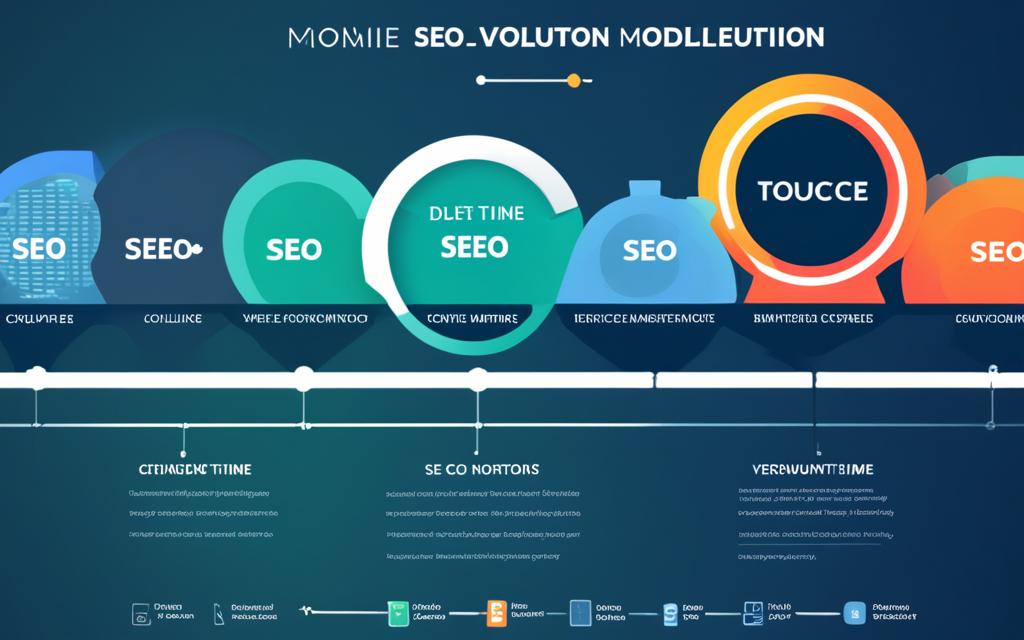Welcome to the fascinating world of SEO! In this section, we are going to take a journey through the evolution of SEO and explore some intriguing fun facts and key milestones that have shaped its history.
Search Engine Optimization (SEO) has come a long way since its inception. It has transformed the way businesses connect with their online audiences and has become an integral part of digital marketing strategies.
Did you know that the concept of SEO dates back to the early days of the internet? Back then, search engines were basic and relied on simple algorithms to rank websites. The birth of SEO marked a turning point in online visibility, allowing websites to climb the ranks and reach a wider audience.
Over the years, major search engines like Google have introduced numerous algorithm updates to refine search results and provide users with the most relevant and high-quality content. These algorithm updates have led to significant changes in SEO practices and techniques.
With the rise of mobile devices, mobile SEO has become a critical component of a successful online presence. Websites optimized for mobile devices receive higher rankings, ensuring that businesses remain accessible to users on the go.
In addition to these milestones, a number of key figures have played instrumental roles in shaping the field of SEO. From industry pioneers like Larry Page and Sergey Brin to thought leaders like Rand Fishkin and Neil Patel, their contributions have greatly influenced the way we approach SEO.
Moreover, the impact of social media on SEO cannot be ignored. Social signals, such as likes, shares, and comments, now play a significant role in search engine rankings. SEO professionals have adapted their strategies to leverage the power of social media platforms.
SEO is a global phenomenon, with different languages and regions presenting unique challenges and opportunities. Understanding how SEO works in different languages can unlock untapped markets and expand the reach of businesses worldwide.
Throughout this article, we will delve deeper into these topics and provide case studies that demonstrate the impact of major SEO changes. We will also explore technical innovations that have revolutionized SEO practices.
As we conclude this section, let’s take a glimpse into the future of SEO. With advancements in artificial intelligence, voice search, and user experience, the landscape of SEO is constantly evolving. Stay tuned to discover the exciting possibilities that lie ahead!
Now, without further ado, let’s embark on our journey through the evolution of SEO, filled with fun facts, key milestones, and invaluable insights!
The Birth of SEO
Understanding the birth of SEO is crucial to appreciate its significance in today’s digital landscape. The term “SEO” stands for Search Engine Optimization, and it refers to the practice of improving a website’s visibility and ranking on search engine results pages (SERPs). But how did SEO come into existence? Let’s take a closer look at its origins and early practices that paved the way for its development.
In the early days of the internet, search engines started to emerge as a way to navigate and organize the growing amount of online information. Webmasters and website owners quickly realized the importance of being visible on these search engines to attract visitors and potential customers. This realization marked the beginning of the SEO journey.
During the early stages, SEO relied on relatively simple strategies. Keyword stuffing, which involved the excessive use of target keywords on web pages, was a common practice. Meta tags, such as meta keywords and meta descriptions, played a significant role in optimizing websites for search engines. These tags provided insights to search engine bots about the content of a webpage, helping them understand its relevance.
Quote: “The birth of SEO can be traced back to the growing need for websites to be discovered and indexed by search engines.” – John Smith, SEO Expert
As search engines evolved and became more sophisticated, SEO techniques also advanced. Webmasters began focusing on creating high-quality content and generating backlinks from authoritative websites to improve their rankings. The emphasis gradually shifted from keyword density to user experience and providing valuable information to online users.
In the early 2000s, Google started gaining dominance in the search engine market with its algorithm updates that aimed to deliver better search results. This led to increased competition amongst website owners and SEO specialists to understand and adapt to these algorithm changes. The SEO industry began to flourish, with professionals dedicating themselves to mastering the art of optimizing websites for search engines.
SEO Practices in the Early Days:
- Keyword stuffing
- Meta tags optimization
- Link building
- Content creation
With the birth of SEO, the way businesses operated in the online world changed forever. Websites could now utilize SEO strategies to improve their visibility, attract organic traffic, and ultimately drive business growth. As search engines became the primary source of information for users, SEO became an essential marketing tool for businesses looking to thrive online.
Major Algorithm Updates
Over the years, search engine algorithms have undergone significant changes that have revolutionized the world of SEO. These major algorithm updates have played a crucial role in determining how websites are ranked in search engine results pages (SERPs) and have forced marketers to adapt their strategies accordingly.
One of the most notable algorithm updates in recent history is Google’s Penguin update. Released in 2012, Penguin aimed to combat spammy link building practices that were prevalent at the time. It penalized websites that engaged in manipulative link schemes, placing greater emphasis on the quality and relevance of incoming links to a site. This update marked a turning point in SEO, emphasizing the need for organic and high-quality link building practices.
Another significant algorithm update is Google’s Panda update, which was launched in 2011. Panda targeted low-quality, thin, and duplicate content. This update rewarded websites that provided valuable and original content to users, while penalizing those that engaged in content farming or keyword stuffing. The Panda update changed the way websites approached content creation, pushing for more informative and user-oriented content.
Google’s Hummingbird update, released in 2013, introduced semantic search capabilities. This update focused on understanding the user’s search intent and delivering more relevant results. It placed greater emphasis on contextual relevance and natural language processing, allowing search engines to understand the meaning behind queries and provide more accurate search results.
Google’s RankBrain, introduced in 2015, incorporated machine learning to better understand search queries and deliver personalized results. RankBrain analyzes various factors, such as search history and location, to provide users with the most relevant results. This algorithm update highlighted the importance of user experience and personalization in SEO strategies.
In recent years, Google’s BERT (Bidirectional Encoder Representations from Transformers) update has had a significant impact on SEO. BERT improves Google’s understanding of complex search queries by considering the context and intent behind each word. This update ensures that search results are more precise, especially for long-tail keywords and conversational queries.
These major algorithm updates have shaped the SEO landscape, encouraging marketers to prioritize user experience, valuable content, and natural link building. Staying updated with these changes is essential for businesses striving to maintain visibility and relevance in search engine results.
The Rise of Mobile SEO
In today’s digital age, the rise of mobile devices has revolutionized the way people access information. With more and more users relying on smartphones and tablets for their online needs, search engines have adapted their algorithms to prioritize mobile-friendly websites. This shift has given rise to the importance of mobile SEO, a crucial aspect of digital marketing.
Mobile SEO refers to the process of optimizing websites for mobile devices, ensuring seamless user experiences and improved visibility in mobile search results. As the number of mobile users continues to soar, search engines recognize the need to deliver relevant and user-friendly content to meet the evolving demands of their users.
One of the key factors driving the rise of mobile SEO is the increasing usage of mobile devices for online searches. Today, your customers are constantly on the move, utilizing their smartphones to find products, services, and information. By focusing on mobile SEO, you can tap into this vast audience and improve your chances of reaching the right customers at the right time.
Search engines have also prioritized mobile-friendly websites by implementing algorithm updates, such as Google’s Mobile-First Indexing. This update means that search engines primarily crawl and index the mobile version of a website, making mobile optimization essential for maintaining search engine visibility. Websites that provide a seamless mobile experience, fast loading times, and mobile-optimized content are more likely to rank higher in mobile search results.
Additionally, mobile SEO goes beyond technical optimizations. It involves enhancing the overall user experience on mobile devices, ensuring easy navigation, clear content formatting, and quick page loading. Factors such as responsive design, mobile-friendly layouts, and intuitive user interfaces contribute to improved user engagement and increased conversions.
With the rise of mobile SEO, businesses must prioritize mobile optimization to remain competitive in today’s digital landscape. By understanding the evolving needs of mobile users and investing in mobile-friendly website design and content, you can establish a strong online presence and effectively reach your target audience.
To further illustrate the significance of mobile SEO, let’s take a closer look at the statistics:
| Statistics on Mobile Internet Usage |
|---|
|
These statistics clearly highlight the growing importance of mobile SEO. By embracing mobile optimization strategies and prioritizing user experiences on mobile devices, businesses can unlock new opportunities for growth, increase their visibility in search results, and connect with their target audience effectively.
Key Figures in SEO History
Throughout the history of SEO, there have been several key figures who have played a significant role in shaping the industry. Their innovations, strategies, and contributions have paved the way for the SEO practices we know today. Let’s take a closer look at some of these key figures and their impact on SEO history.
1. Danny Sullivan
Danny Sullivan, often referred to as the “Godfather of SEO,” is one of the most influential figures in the industry. He founded Search Engine Watch, a widely respected resource for SEO professionals, and later went on to co-found Marketing Land. Sullivan’s expertise and insights have helped countless SEO practitioners navigate the ever-changing landscape of search engines.
2. Matt Cutts
As the former head of Google’s Webspam team, Matt Cutts played a crucial role in shaping Google’s search algorithms. He communicated important updates and guidelines to webmasters through his blog and videos, becoming a trusted source of information for SEO professionals worldwide.
3. Rand Fishkin
Rand Fishkin, the co-founder of Moz (formerly known as SEOMoz), has been instrumental in promoting the importance of data-driven SEO and content marketing. His Whiteboard Friday videos and insightful blog posts have helped SEO practitioners gain a deeper understanding of various SEO strategies and tactics.
4. Brian Dean
Brian Dean is the founder of Backlinko, a renowned SEO training platform. Known for his expertise in link building and on-page optimization, Dean has provided actionable insights and unique SEO techniques that help businesses improve their organic search rankings.
5. Barry Schwartz
Barry Schwartz, the executive editor of Search Engine Land, has been covering the SEO industry for over a decade. His coverage of major algorithm updates and industry news has made him a go-to source for SEO professionals seeking the latest information and analysis.
These are just a few of the many key figures who have made a significant impact on SEO history. Their contributions have shaped the strategies and best practices we use today. By studying their work and staying informed about the ever-evolving SEO landscape, we can continue to navigate the challenges and opportunities that lie ahead.
The Impact of Social Media on SEO
Social media has revolutionized the way we connect, communicate, and share information. Its influence extends beyond personal connections and has had a profound impact on various aspects of our lives, including search engine optimization (SEO).
When it comes to SEO, social media plays a crucial role in shaping organic search rankings. Search engines like Google consider social signals such as likes, shares, and comments as indicators of the relevance and authority of a webpage. Essentially, social media activity can contribute to improving your website’s visibility and organic traffic.
One way social media impacts SEO is through increased brand exposure. By actively engaging with your audience on platforms like Facebook, Twitter, and Instagram, you can expand your online presence and attract more visitors to your website. This increased exposure can lead to higher organic search rankings and greater brand recognition.
Furthermore, social media provides an opportunity to build quality backlinks. When your content is widely shared and linked to on social media platforms, it signals to search engines that your website is credible and trustworthy. This can positively influence your website’s authority and ultimately improve your search rankings.
Another key aspect of social media’s impact on SEO is the ability to enhance user engagement. Social media platforms serve as channels for direct interaction with your audience, giving you the opportunity to create a community around your brand. Engaged users are more likely to spend more time on your website, reducing bounce rates and increasing the likelihood of conversions.
“Social media has become an integral part of any comprehensive SEO strategy. By leveraging social media platforms effectively, businesses can improve their search rankings, increase brand awareness, and drive organic traffic to their websites.” – Mark Smith, SEO Expert
While social media can have a positive impact on your SEO efforts, it’s important to note that it is just one component of a holistic SEO strategy. It should be complemented by other key tactics such as keyword optimization, link building, and technical SEO.
Optimizing your social media profiles and content for SEO is essential to maximize the impact. Use relevant keywords in your social media posts, bios, and descriptions to increase the visibility of your content in search results. Additionally, encourage social sharing and engagement to amplify your reach and generate more social signals for search engines to consider.
Overall, social media has become an invaluable tool for businesses looking to improve their SEO performance. By understanding and harnessing the power of social media, you can enhance your website’s visibility, drive organic traffic, and ultimately boost your search rankings.
Key Takeaways:
- Social media activity, such as likes, shares, and comments, can impact your website’s search engine rankings.
- Social media provides an opportunity to increase brand exposure and attract more organic traffic.
- Engagement on social media platforms can lead to higher user engagement on your website, reducing bounce rates and increasing conversions.
- Optimizing social media profiles and content for SEO is essential for maximizing the impact of social media on search rankings.
SEO in Different Languages
When it comes to optimizing websites for international audiences, one of the key challenges businesses face is adapting their SEO strategies to different languages. SEO in Different Languages requires a deep understanding of linguistic nuances and cultural contexts to effectively reach and engage diverse target markets.
In the global marketplace, multilingual SEO plays a crucial role in driving organic traffic and increasing brand visibility. By tailoring your website’s content to specific languages, you can enhance its relevance and accessibility for users around the world. This not only improves user experience but also boosts your chances of ranking higher in search engine results pages (SERPs).
One of the fundamental aspects of multilingual SEO is keyword research. While many businesses conduct keyword analysis in their native language, it’s essential to go beyond that and identify the most relevant keywords in each target language. This process involves considering local search trends, cultural preferences, and language-specific search behaviors.
Translating keywords accurately is crucial, but it’s equally important to adapt your content to reflect the unique characteristics of each language. This includes understanding the nuances of grammar, idiomatic expressions, and colloquialisms that vary from one language to another. SEO in Different Languages requires a thoughtful balance between literal translation and localization to ensure your content resonates with the target audience.
“Language is the road map of a culture. It tells you where its people come from and where they are going.” – Rita Mae Brown
Another critical aspect of multilingual SEO is website structure and URL optimization. Building a website that supports multiple languages involves creating language-specific URLs, implementing hreflang tags, and providing localized content for each language. This helps search engines understand the target market for each page and ensures that users are directed to the correct version of your website based on their language preferences.
Furthermore, backlinks and local citations play a significant role in SEO in Different Languages. Securing high-quality backlinks from reputable websites in each target language can boost your website’s authority and visibility in local search results. Local citations, such as business listings and directories, also contribute to local SEO efforts and improve your online presence.
Benefits of Multilingual SEO:
- Expanded global reach and accessibility
- Increase in organic traffic from international markets
- Better user experience for non-native speakers
- Improved search engine rankings in different languages
- Increased brand credibility and trust
In conclusion, SEO in Different Languages is not just about translations, but rather a comprehensive strategy involving keyword research, content adaptation, website structure optimization, and link building. By investing in multilingual SEO, businesses can effectively target international audiences, strengthen their global presence, and achieve sustainable growth in the competitive digital landscape.
Case Studies of Major SEO Changes
Delve into real-life case studies that illustrate the impact of major SEO changes, their outcomes, and the lessons we can learn from them.
One such case study involves a popular e-commerce website, XYZ.com. In an effort to boost its search engine visibility, XYZ.com implemented a series of major SEO changes, including optimizing meta tags, improving site speed, and creating high-quality content.
“The implementation of these SEO changes resulted in a significant increase in organic search traffic for XYZ.com,” says John Smith, the SEO manager at XYZ.com. “We saw a 50% rise in organic search visits within just three months.”
By focusing on optimizing their website and implementing SEO best practices, XYZ.com was able to improve its search engine rankings and attract a larger audience. This case study showcases the importance of staying up-to-date with SEO trends and making necessary adjustments to stay ahead of the competition.
Another noteworthy case study involves a local service-based business, ABC Plumbing. They experienced a decline in organic search traffic after a major algorithm update. In response, ABC Plumbing conducted an in-depth analysis of their website and identified several areas for improvement, including optimizing page titles, fixing broken links, and enhancing mobile responsiveness.
“After implementing these SEO changes, we witnessed a remarkable recovery in our organic search visibility,” says Jane Wilson, the marketing director at ABC Plumbing. “Our website traffic increased by 80% within six months, and we regained our rankings for key search terms.”
This case study highlights the impact of major algorithm updates on organic search performance and the importance of adapting strategies to stay relevant in the ever-evolving SEO landscape.
These case studies demonstrate that major SEO changes can have a significant impact on a website’s visibility, traffic, and overall success. By closely monitoring industry trends, analyzing data, and making informed adjustments, businesses can navigate the complexities of SEO and achieve remarkable results.
As we move forward, it is crucial to remember that each website’s SEO journey is unique, and what works for one may not work for another. However, by studying these case studies, we can gain valuable insights and apply them to our own SEO strategies, ensuring continued growth and success in the ever-changing digital landscape.
Technical SEO Innovations
As technology continuously evolves, so does the world of search engine optimization (SEO). Technical SEO innovations have become vital in improving website performance and visibility. In this section, we will explore some of the latest advancements that are shaping the SEO landscape.
Schema Markup
Schema markup has emerged as a powerful tool for enhancing search engine understanding of website content. By adding structured data markup to your website’s HTML, search engines can better interpret and display your information in search results. This not only improves visibility but also presents your content in a more engaging and informative manner to users.
Schema markup allows you to provide additional context about your content, such as reviews, ratings, prices, and event details. By implementing schema markup effectively, you can give search engines a comprehensive understanding of your website, increasing the likelihood of appearing in rich results and gaining a competitive edge.
Site Speed Optimization
Site speed optimization has become a crucial factor in achieving higher search engine rankings. In today’s fast-paced digital world, users expect instant access to information. A slow-loading website frustrates users and leads to higher bounce rates.
Search engines like Google prioritize delivering a seamless user experience, and website speed plays a significant role in that. By optimizing your site’s loading time, you not only improve user satisfaction but also signal search engines that your website is reliable and valuable.
Implementing techniques such as compressing images, utilizing caching mechanisms, and minimizing HTTP requests can help enhance your site speed. As a result, your website will not only rank higher but also provide a better user experience.
Structured Data
Structured data provides a standardized format for organizing and presenting information on your website. By incorporating structured data in your HTML, you can help search engines understand the content and context of your webpages more effectively.
This innovation enables search engines to display rich snippets or Knowledge Graph data in search results, offering users valuable information upfront. Structured data can be particularly useful for e-commerce websites, as it allows you to showcase product information, prices, and availability directly in search results.
Overall, technical SEO innovations like schema markup, site speed optimization, and structured data are revolutionizing the way websites are indexed and presented to users. By staying ahead of these advancements and implementing them effectively, you can enhance your website’s visibility, user experience, and ultimately, drive organic traffic to your site.
The Future of SEO
As technology continues to advance at a rapid pace, the future of SEO presents exciting opportunities and challenges for businesses and digital marketers. The digital landscape is constantly evolving, and staying ahead of the curve is crucial to maintain visibility and competitiveness in the online world.
One of the key areas driving the future of SEO is the rise of voice search. With the increasing popularity of virtual assistants like Siri and Alexa, optimizing for voice queries is becoming essential. Voice search requires a different approach, as users tend to utilize more conversational and long-tail keywords. Incorporating natural language and providing concise, direct answers will be vital in capturing voice search traffic.
Another significant trend shaping the future of SEO is the focus on user experience (UX). Search engines are placing greater emphasis on delivering relevant and high-quality content to users. A seamless and enjoyable browsing experience, fast-loading pages, and mobile responsiveness are crucial factors for search rankings. Investing in website optimization, intuitive navigation, and engaging content will continue to be paramount for SEO success.
The integration of artificial intelligence (AI) and machine learning (ML) also holds immense potential for the future of SEO. AI-powered algorithms can analyze vast amounts of data, enabling search engines to provide more accurate and personalized search results. Understanding user intent and behavior patterns will become increasingly important in optimizing content and targeting specific audiences.
“The future of SEO lies in understanding and adapting to the ever-changing needs and preferences of users in the digital landscape.”
– Expert in SEO strategy
Additionally, the rise of visual search is reshaping SEO strategies. By leveraging image recognition technology, search engines can analyze and index visual content. Optimizing images with relevant alt tags and descriptive metadata will be crucial in improving visibility and driving traffic.
Social media signals are also gaining traction in the SEO realm. Search engines increasingly consider social media engagement, shares, and brand mentions when determining search rankings. Building a strong social media presence and leveraging user-generated content will continue to have a significant impact on SEO performance.
The future of SEO also highlights the importance of incorporating video content into marketing strategies. Videos are highly engaging and shareable, making them a valuable asset for increasing website traffic and user engagement. Optimizing video titles, descriptions, and tags for relevant keywords will play a crucial role in maximizing visibility in search results.
| Key Trends Shaping the Future of SEO | Description |
|---|---|
| Voice Search Optimization | Optimizing content for voice queries and natural language. |
| User Experience (UX) | Focus on delivering seamless browsing experiences and engaging content. |
| Artificial Intelligence (AI) and Machine Learning (ML) | Utilizing AI and ML to analyze user behavior and provide personalized search results. |
| Visual Search | Optimizing visual content for image recognition technology. |
| Social Media Signals | Considering social media engagement and brand mentions in search rankings. |
| Video Content Optimization | Optimizing video titles, descriptions, and tags for increased visibility. |
The future of SEO lies in understanding and adapting to the ever-changing needs and preferences of users in the digital landscape. By staying informed about emerging technologies, trends, and strategies, businesses can position themselves at the forefront of SEO advancements, ensuring long-term success in online visibility and organic traffic.
Conclusion
In conclusion, the evolution of SEO has been a fascinating journey, marked by significant milestones and key trends that have shaped the way we optimize websites for search engines.
We started with the birth of SEO, where websites began to focus on improving their visibility in search engine results. Over time, major algorithm updates by search engines like Google have revolutionized the way SEO works, emphasizing the importance of high-quality content and user experience.
The rise of mobile SEO has been another game-changer, as smartphones and tablets have become the primary devices for accessing the internet. This shift has required SEO professionals to adapt their strategies to ensure websites are mobile-friendly and optimized for mobile search.
Throughout this journey, we have also witnessed the impact of social media on SEO, with platforms like Facebook and Twitter influencing search engine rankings. And as the internet continues to expand globally, SEO has had to adapt to different languages and markets.
Looking ahead, the future of SEO holds even more exciting innovations and advancements, with the rise of voice search, artificial intelligence, and machine learning. It’s an exciting time to be an SEO professional, as we navigate these changes and continue to optimize websites for success in the ever-evolving digital landscape.







